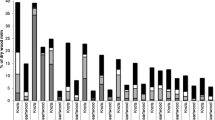Abstract
Total amount and composition of extractives from 12 different tropical wood species were determined by sequential extraction followed by silylation and GC, GC/MS analysis. Hexane and then acetone/water (5:1) mixture was used successively for the extraction. Generally, very low amounts of lipophilics were found (0.05–0.38 mg/g) and the constituent consisted of fatty acids. Hydrophilics were composed of phenolic acids, flavonoids, sterols, stilbenes and a lignan. The highest amount of hydrophilics was found in Afzelia (36.1 mg/g), while the lowest in Wenge and Opepe (0.30 mg/g). Also, cold-hot water, 1% NaOH and some solvent (acetone, dichloromethane) solubilities were determined. The solubility values of tropical woods except for Canalete were found to increase in the order of solvent, cold water, hot water and 1% NaOH.
Zusammenfassung
Die Gesamtmenge und die Zusammensetzung der Extraktstoffe von zwölf verschiedenen Tropenholzarten wurden mittels sequentieller Extraktion und anschließender Silylierung und GC, GC/MS-Analyse bestimmt. Für die Extraktion wurden nacheinander Hexan und eine Aceton/Wasser-Mischung (5:1) verwendet. Generell wurden geringe Mengen an lipophilen Substanzen (0,05–0,38 mg/g) gefunden und die Bestandteile setzten sich aus Fettsäuren zusammen. Die hydrophilen Substanzen setzten sich aus Phenolsäuren, Flavonoiden, Sterinen, Stilbenen und einem Lignan zusammen. Afzelia wies die höchste Menge an hydrophilen Substanzen auf (36,1 mg/g), während in Wenge und Opepe mit 0,30 mg/g die niedrigste Menge gefunden wurde. Daneben wurde auch die Löslichkeit in kaltem und heißem Wasser sowie in 1 % NaOH und einigen Lösemitteln (Aceton, Dichlormethan) bestimmt. Die Löslichkeit der Tropenhölzer nahm außer bei Canalete in der Reihenfolge Lösemittel, kaltes Wasser, warmes Wasser und 1 % NaOH zu.
Similar content being viewed by others
References
Choong E, Achmadi SS (1991) Effect of extractives on moisture sorption and shrinkage in tropical woods. Wood Fiber Sci 23(2):185–196
Deon G, Chadenson M, Hauteville M (1980) Influence of extractives on the natural resistance of wood decay. Rev Bois For Trop 191 (in French)
Ekman R, Holmbom B (1989) Analysis by gas chromatography of wood extractives in wood and pulp samples from mechanical pulping of spruce. Nord Pulp Pap Res J 41:16–24
Fengel D, Wegener G (2003) Wood chemistry, ultrastructure, reactions. Verlag Kessel, Remagen
Food and Agriculture Organization of the United Nations (FAO) (2005) Report
Hafizoglu H (1987) Studies on the chemistry of Cedrus libani A. Rich I. Wood extractives of Cedrus libani. Holzforschung 41:27–38
Hafizoglu H (1989) Studies on the wood and bark constituents of Pinus pinea L. Holzforschung 43:41–43
Hafizoglu H, Holmbom B (1995) Chemical composition of extractives from Abies nordmanniana. Holz Roh-Werkst 53:273–275
Hernandez R (2007a) Effects of extraneous substances, wood density and interlocked grain on fiber saturation point of hardwoods. Wood Mater Sci Eng 2:45–53
Hernandez R (2007b) Swelling properties of hardwoods as affected by their extraneous substances, wood density and interlocked grain. Wood Fiber Sci 39(1):146–158
Hernandez R (2007c) Influence of accessory substances, wood density and interlocked grain on the compressive properties of hardwoods. Wood Sci Technol 41:249–265
Hernandez R (2007d) Moisture sorption properties of hardwoods as affected by their extraneous substances wood density and interlocked grain. Wood Fiber Sci 39(1):132–145
Popper R, Niemz P, Eberle G (2007) Influence of extractives on water vapour sorption by the example of wood species from Chile. Wood Res 52(1):57–68
Popper R, Niemz P, Torres M (2006) Einfluss des Extraktstoffanteils ausgewählter fremdländlischer Holzarten auf deren Gleichgewichtsfeuchte. Holz Roh- Werkst 64:491–494
TAPPI T-204 Solvent extraction of wood and pulp
TAPPI T-257 Sampling and preparing wood for analysis
TAPPI T-207 Water solubility of wood and pulp
TAPPI T-212 One percent sodium hydroxide solubility of wood and pulp
Acknowledgements
The authors wish to thank Markku Reunanen, Laboratory of Wood and Paper Chemistry, Åbo Akademi Turku-Finland for performing the Mass Spectras.
Author information
Authors and Affiliations
Corresponding author
Rights and permissions
About this article
Cite this article
Kilic, A., Niemz, P. Extractives in some tropical woods. Eur. J. Wood Prod. 70, 79–83 (2012). https://doi.org/10.1007/s00107-010-0489-8
Received:
Published:
Issue Date:
DOI: https://doi.org/10.1007/s00107-010-0489-8




